Autoblog Returns For Another Crack At The 200-MPH Club
Driving 200 miles per hour has always been at the top of my bucket list. Unfortunately, accomplishing this dream has always eluded me as it is laden with seemingly insurmountable obstacles. First, the task requires a machine capable of the speed. Second, one needs a very long, straight piece of pavement. Lastly, there is the hurdle of the law - getting tagged at three times the typical legal limit will not only seriously ruin your weekend, but also take a sizable chunk of money (and probably a driver's license) out of your leather wallet.
After decades of frustration, World Class Driving has come to my rescue. The same company that has been touring the nation with its fleet of expensive exotics, offering regular civilians the opportunity to drive on road and track, offers the "200 mph Challenge." In a nutshell, they provide the cars, pavement and amnesty from the law in one turnkey package. It isn't cheap ($4,995 for this program), but successful completion puts participants in a very exclusive group of non-professionals who have driven 200 mph. To put it into perspective, more people have been launched into space.
Participants are an eclectic group. Of the 16 in my class, there are prominent physicians, attorneys, CEOs and wealthy adventurists who do it for sport (you know, the kind who travel to Russia for a supersonic flight in a Mikoyan MiG-29). There is also young 16-year-old Alec Feintuch, attending through the Make-A-Wish Foundation. Poignantly, I'm not the only one with the dream of driving 200 mph.
Continue Reading World Class Driving offers pieces to the 200-MPH puzzle. We assemble them...
World Class Driving 200 MPH Challenge - Click above for high-res image gallery
Driving 200 miles per hour has always been at the top of my bucket list. Unfortunately, accomplishing this dream has always eluded me as it is laden with seemingly insurmountable obstacles. First, the task requires a machine capable of the speed. Second, one needs a very long, straight piece of pavement. Lastly, there is the hurdle of the law - getting tagged at three times the typical legal limit will not only seriously ruin your weekend, but also take a sizable chunk of money (and probably a driver's license) out of your leather wallet.
After decades of frustration, World Class Driving has come to my rescue. The same company that has been touring the nation with its fleet of expensive exotics, offering regular civilians the opportunity to drive on road and track, offers the "200 mph Challenge." In a nutshell, they provide the cars, pavement and amnesty from the law in one turnkey package. It isn't cheap ($4,995 for this program), but successful completion puts participants in a very exclusive group of non-professionals who have driven 200 mph. To put it into perspective, more people have been launched into space.
Participants are an eclectic group. Of the 16 in my class, there are prominent physicians, attorneys, CEOs and wealthy adventurists who do it for sport (you know, the kind who travel to Russia for a supersonic flight in a Mikoyan MiG-29). There is also young 16-year-old Alec Feintuch, attending through the Make-A-Wish Foundation. Poignantly, I'm not the only one with the dream of driving 200 mph.
Continue Reading World Class Driving offers pieces to the 200-MPH puzzle. We assemble them...
Photos copyright ©2011 Drew Phillips / AOL
Early last year, World Class Driving invited us to Florida's Miami Dade-Collier Training and Transition airport for a shot at 200 mph. Unfortunately, its 10,500 feet of runway didn't give us a chance to complete wring out a Lamborghini Gallardo Superleggera. Our Man Damon Lavrinc finished the day for us with a personal best of 199 mph. We're back to try again, this time at World Class Driving's recent West Coast event that offers a much longer runway.
Mojave is a town of just 4,000 residents located in the high desert north of Los Angeles. The small community skirting the edge of Edwards Air Force Base earned international fame most recently in October 2004 when its over-sized airport (a former Marine Corps auxiliary air station) was used by Scaled Composites to launch a private rocket-propelled plane into space. Less than seven years later, Mojave Air and Space Port is hosting 16 drivers trying to break the 200-mph barrier - sans rocket assist - without leaving the surface of the runway.
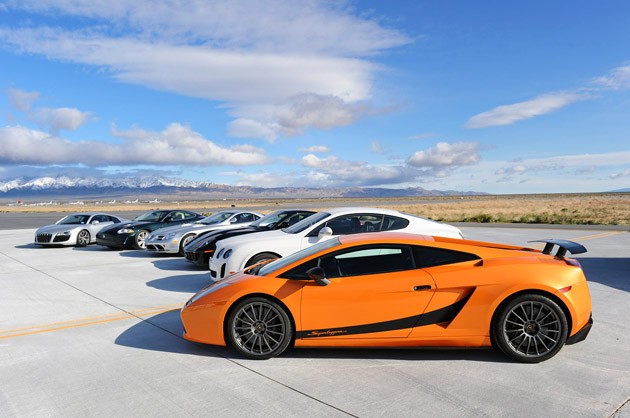
After a continental breakfast at the Mariah Hotel, we jump into our own cars and travel in a security-escorted caravan across the street to the Mojave Air and Space Port (the airport was officially certified as a "space port" by the FAA in 2004). Our slow pace eventually takes us to "Hammer Head," a large concrete pad engineered to allow big jets to test their engines, near the end of runway 12-30. It is windy, and very cold.
Fanned out on the light gray surface are six supercars, each highly polished, wearing a fresh set of Pirelli P Zero tires and a new set of brake pads (the Rolls-Royce Ghost, sneaking around the tarmac in a few of the images, was driven to the event by one of the event participants). All of the vehicles are equipped with automatic transmissions. The exotics, with a combined retail value of more than $1 million, are parked as if waiting for someone with a camera to do a photo shoot for a fantasy dorm room poster:
Audi R8 V10 5.2 FSI
5.2-liter V10 rated at 525 horsepower (manufacturer claimed top speed 196 mph)
Bentley Continental Supersports Coupé
Twin-turbocharged 6.0-liter W12 rated at 621 horsepower (manufacturer claimed top speed 204 mph)
Ferrari 599 GTB Fiorano
6.0-liter V12 rated at 611 horsepower (manufacturer claimed top speed 205+ mph)
Jaguar XKR
Supercharged 5.0-liter V8 rated at 510 horsepower (electronically limited to 155 mph)
Lamborghini Gallardo Superleggera
5.2-liter V10 rated at 561 horsepower (manufacturer claimed top speed 202 mph)
Mercedes-Benz SLR McLaren
Supercharged 5.4-liter V8 rated at 617 horsepower (manufacturer claimed top speed 208 mph)
With the exception of the Jaguar coupe, each of the cars is part of the World Class Driving fleet. All were hand-picked and trucked to the site, solely for their ability to break the 200-mph barrier. The Jaguar, on the other hand, was on loan from the manufacturer (who likely had no idea it was going to be used in this capacity as it was capped with a limiter).
World Class Driving has erected a large tent (thankfully, with a heater) at the end of the pad to protect us from the elements. Stocked with food and drink, and a clean restroom trailer, the temporary structure serves as our "base camp" for the day. It is also the classroom for our chalk-talk, a short overview describing the schedule.
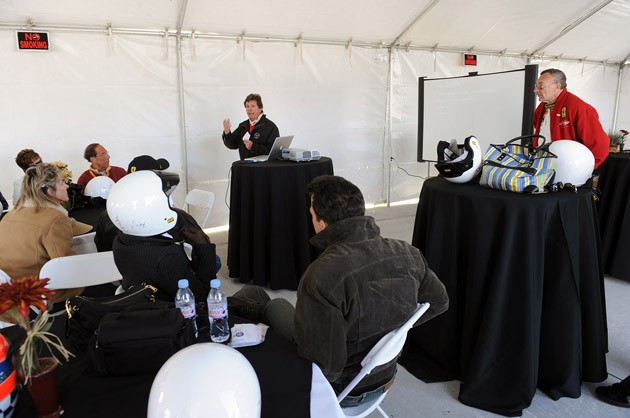
The first item on our agenda is to move the cars over to another part of the spaceport for a few training exercises - the hands-on lessons give each of us a chance to drive nearly all of the vehicles and become accustomed to their controls and sensitivities. Two professional racers, Didier Theys and Roland Linder, will be our instructors (the pair is brave enough to keep the passenger seats warm throughout the day).
With orange cones placed strategically on the wide tarmac, and instructions to avoid the countless blue taxiway edge lights dotting the landscape, each of us takes turns at a high-speed 90-degree sweeper followed by full-throttle acceleration. The exercise is designed to teach us the proper way to enter the main runway for our high speed run without spinning the rear wheels (and losing critical entry speed) upon exiting the corner.
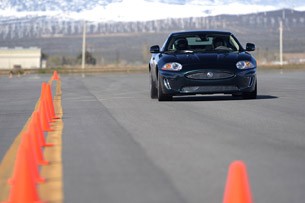
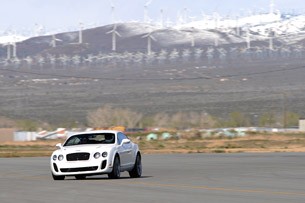
The second exercise has the group driving through cones in a giant slalom. Once we exit the markers, the accelerator is floored and our speed increases rapidly. At the next set of cones we brake hard. The exercise is designed to teach us vehicle balance and proper high-speed braking technique.
After a few hours, all of us have had numerous rounds in the Audi, Bentley, Jaguar and Lamborghini. Chatter in the paddock reveals most of the non-professional participants are amazed with the 4,800-pound Continental Supersports - it handles so surprisingly well that it makes the Jaguar XKR feel downright sloppy. The sexy Superleggera, with its carbon-fiber cockpit, is also a class favorite.
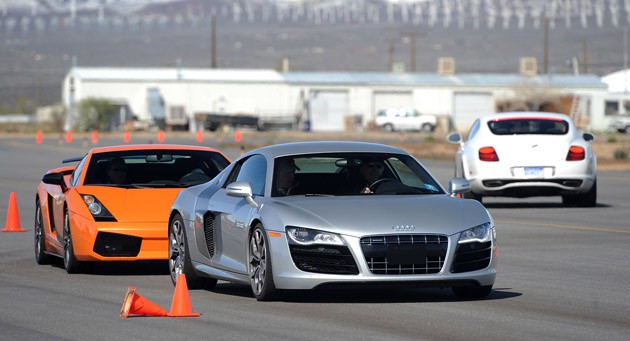
Following a well-presented catered lunch (better than most sit-down meals of which I partake), it is time for the main event. Standing outside, with the 40-degree wind blowing across the tarmac, I am shivering - cold, nervous and excited.
The main runway at Mojave Air and Space Port is huge. Easily capable of handling a full-loaded 747-400 departing to Sydney, it is 12,500 feet of smooth concrete. With generous flat asphalt run-offs on each end, and a full 200-feet wide, it is a perfectly paved 20-lane highway nearly three miles long.
Before we are let loose, the instructors want each of us to take a ride as a passenger down the runway at speed. We don helmets (supplied, if you don't bring one) and pile in to a few of the cars. I climb into the back seat of a Jaguar XJ Supersport, also on loan from the manufacturer. Starting from the east end of the runway, traveling into the wind, the instructor floors the accelerator. The XJ takes off strongly. We pass 100 mph rather quickly, and then climb through 150 mph. At an indicated 160 mph, the acceleration stops - it is electronically limited (to 155 mph). We drive another mile or so wedged at 160 mph until we hit the two rows of bright orange cones indicating the braking zone. Unimpressed with the velocity, we turn around and repeat the run in the opposite direction. Even with a tailwind, the 510-horsepower XJ won't budge past its limiter. That's too bad, as all on board can tell it had more in it. We head back to the tent.
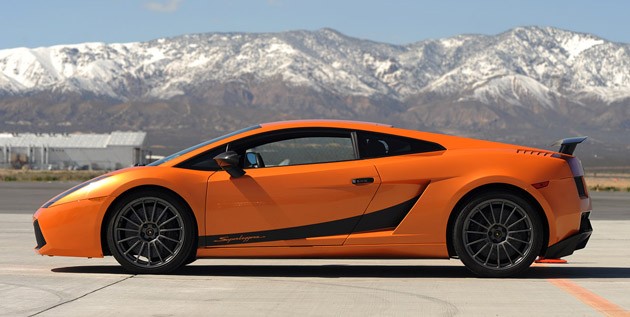
A technical inspection of the Lamborghini reveals its "lifting system" (engineered to raise the nose for additional clearance over steep driveways) has failed. It is acting erratically, raising and lowering the nose at will, which is not something anyone would want to have happen at 200 mph. The Gallardo Superleggera, tilting slightly to one side, is parked for the rest of the day.
The Bentley makes a few top speed runs during the early part of the practice session. Unfortunately, its beastly powerplant (the strongest of the group) can't push its huge frontal area through the atmosphere at more than 194 mph. Unable to prove its ability to crack the magic number, the luxury yacht is retired for the balance of the afternoon as well.
Knowing the Bentley has been averaging "only" about 190 mph during its runs, I choose the Audi for my practice – the sleek, short and stubby R8 V10 has hit 195 mph nearly every time.
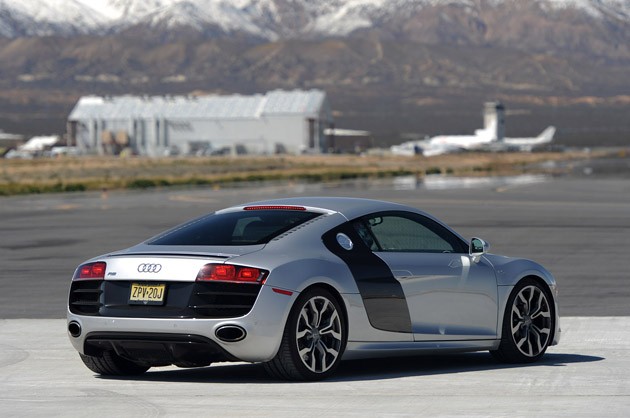
I strap on my helmet, drop into the Audi's cabin and cinch down the three-point belt. One of the instructors outside the car double-checks my seating position, while the instructor in the passenger seat calls out directions and keeps an ear on the radio. (World Class Driving rented the runway, but we still had to get "clearance" from the tower before each run in the event that an aircraft flying overhead had declared an in-flight emergency.) With the V10 firing smoothly, I guide the R8 to the edge of the taxiway.
The wait is the worst part.
While the cars are meticulously inspected (a mechanic is on the team), it's impossible not to sit patiently and wonder about the tightness of the lug nuts, tire pressure, integrity of the brake lines, debris on the track, a gust of wind or a random flock of suicidal birds. To occupy my mind, I again look down and verify the location of the brake pedal with my eyes – as if it had moved since the last time I had checked. Yep, it's still there.
The plan is to launch from a rolling start as every single mile-per-hour is deemed necessary. With a 200-foot-wide runway, the easiest way to accomplish this is by slinging off from a rolling skidpad exercise. Just ensure the nose is pointing forward when you go full throttle.
The radio call comes over. All thumbs are up, and I am off.
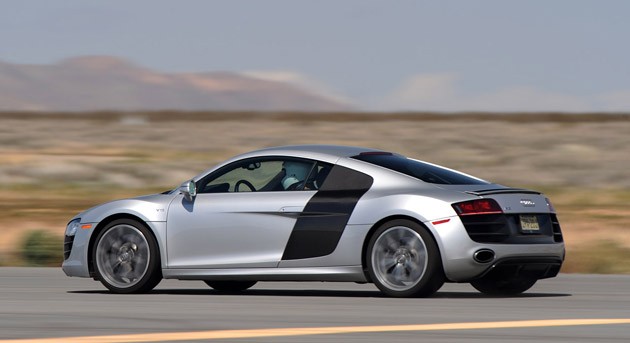
It takes a light throttle to roll down the runway at 35 mph, heading in the wrong direction. I stay to the right, avoiding those impeding (and expensive) runway lights sticking out of the asphalt. As I near the end, my hands wind the flat-bottom steering wheel to the left to start a wide arc across the runway's paved runoff. Mid-corner, my right foot starts twitching. Two seconds later, I mash the accelerator pedal to the floor.
Oddly enough, I don't notice the 525 horses pressing me against the seat. I don't hear the sound of the wailing V10, or the full-throttle shifts as we pass through 100 mph. My only concern lays two miles ahead – I'm scanning for the critical bright-orange braking cones.
Come to think of it, where is the end of the runway? Three miles of flat runway tarmac, heated by mid-day desert sun, is now refracting the light creating a near-perfect mirage. From my low vantage point in the R8, now pushing through 150 mph, I see an expanse of concrete with the illusion of a big lake at the end.
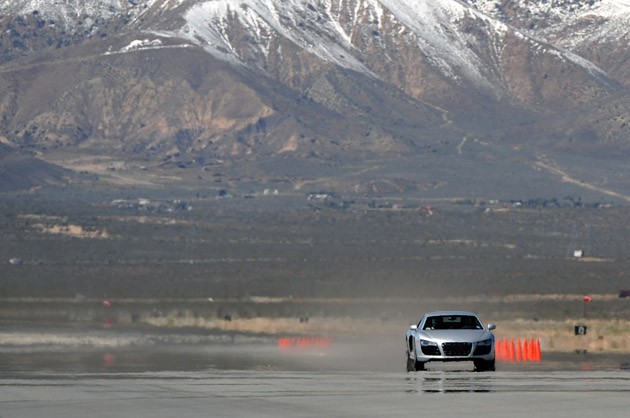
Unruffled, I press even harder on the accelerator pedal.
At 175 mph indicated, the runway is moving under the Audi in a blur. The R8 V10 is very steady at speed. Very slight steering inputs keep it tracking absolutely straight (it hardly wanders at all). Even though the car is buttoned-up tightly and I am wearing a full helmet, there is a lot of wind noise. I glance down and note the speedometer is crawling upwards.
At 185 mph, the first set of cones has come clearly into view about a quarter-mile ahead. Traveling at 271 feet per second, I pass them four seconds later.
Braking is the most dangerous part of the run. While each of the cars is aerodynamically engineered for high speeds, abrupt weight transfer will upset a vehicle's balance - possibly leading to a spin, or worse. In training earlier in the day, we learned to lift off the throttle gently (to settle the car back on all of its wheels) and then firmly apply the brakes (transferring the weight forward). The brakes go from ice cold to very hot in seconds, changing pedal feel underfoot. Hold a firm pedal threshold just above anti-lock intervention or you will run out of pavement.
I bring the R8 V10 to a stop with room to spare and without any drama. (Another driver, in the Ferrari 599, wasn't aggressive enough on the brakes resulting in an unexpected departure from the end of the runway.) According to my professional passenger, I hit an indicated 187 mph. That was while driving into a headwind.
I take several deep breaths. Damn, what a rush!
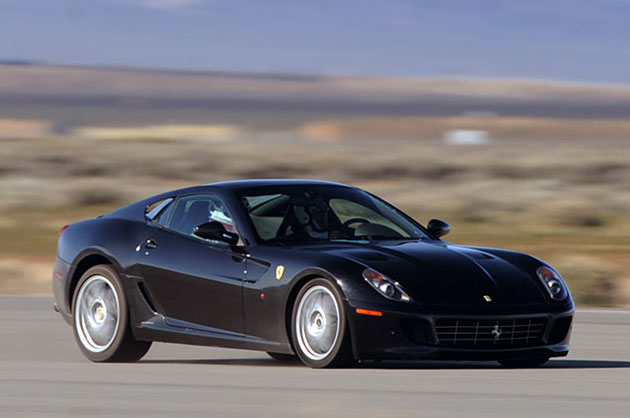
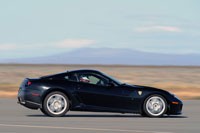
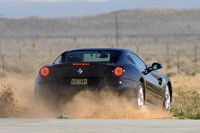
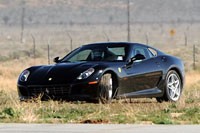
Repeating the same routine from the other direction, I hit an indicated 195 mph on the return trip downwind. (As it turns out, a headwind robs top speed significantly while a tailwind can push a vehicle even faster than its claimed maximum velocity).
An hour later, I find myself staring at the LEDs embedded in the steering wheel of the Ferrari. I want to shift manually, but the instructor convinces me at the last second to let the computer snap off gears (he argues if I miss one shift, there goes my shot at 200 mph). The 599 GTB Fiorano doesn't break a sweat as it easily cracks 200 mph just 45 seconds after I give it full throttle (the vehicle's speedometer indicates 205 mph to the occupants, but the GPS-embedded video shows I nailed 200 mph even). The Ferrari is very easy to drive at these velocities. It pulls strongly through 170 mph, feeling planted the whole time. The standard carbon-ceramic brakes deliver immense and confident stopping power (at the expense of a full set of pads in just one day).
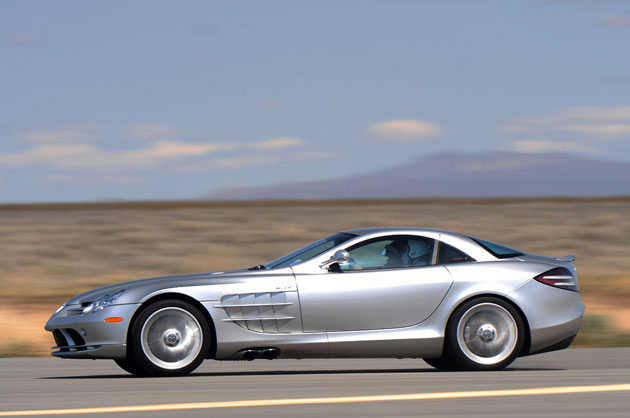
My last run is in the McLaren. Like the Ferrari, its out-of-the-gate acceleration is ferocious. The engine roars and the rear wheels fight for traction. Things settle down for a moment, but above 150 mph, the SLR starts to get a bit skittish. Instead of fighting it, I ease my death-grip on the steering wheel and let it track its own path – just a few feet in each direction – thankfully, that seems to calm things down slightly. At 190 mph, the McLaren still wants to choose its own groove. With nearly 13 more seconds to go at blurry speeds, I am feeling more than a bit uneasy (at this point, I just want to get through the middle of the cones). The SLR hits an indicated 204 mph before I stand on the brake pedal and the airbrake is raised off the rear decklid. I'm sweating and my heart is racing, yet still grinning from ear to ear.
By the end of the afternoon, each of us has broken the 200-mph barrier. Certificates, commemorative shirts and a very nice crystal trophy will serve as conversation pieces for the rest of our lives. My bucket list is finally one item lighter.
What about fearless Alec Feintuch? The young high school student drove an indicated 190 mph in the Bentley Continental GT Supersports, 206 mph in the McLaren SLR and 206 mph in the Ferrari 599 - living a dream sure beats algebra class.

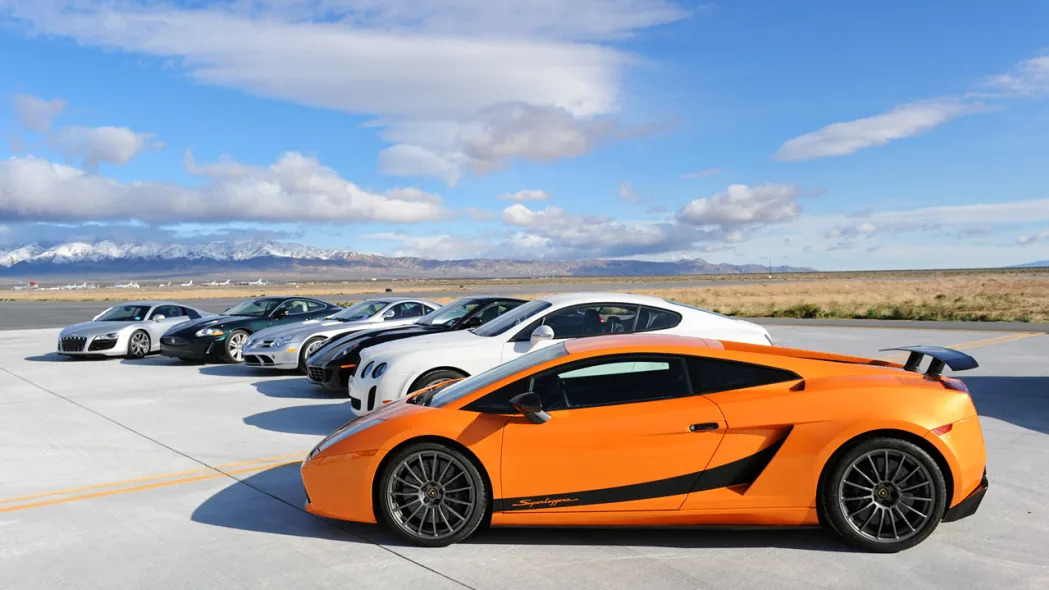
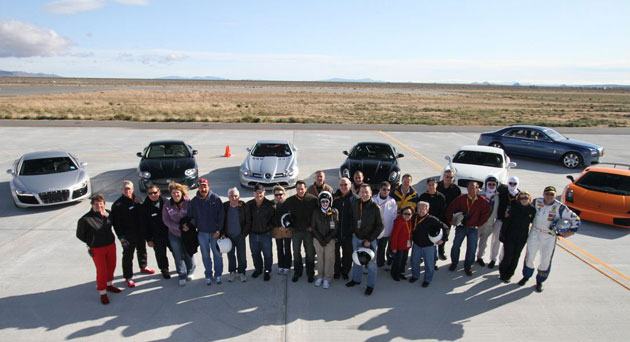

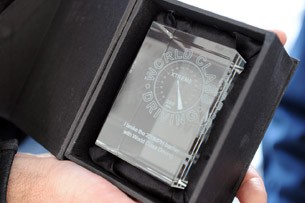

Sign in to post
Please sign in to leave a comment.
Continue